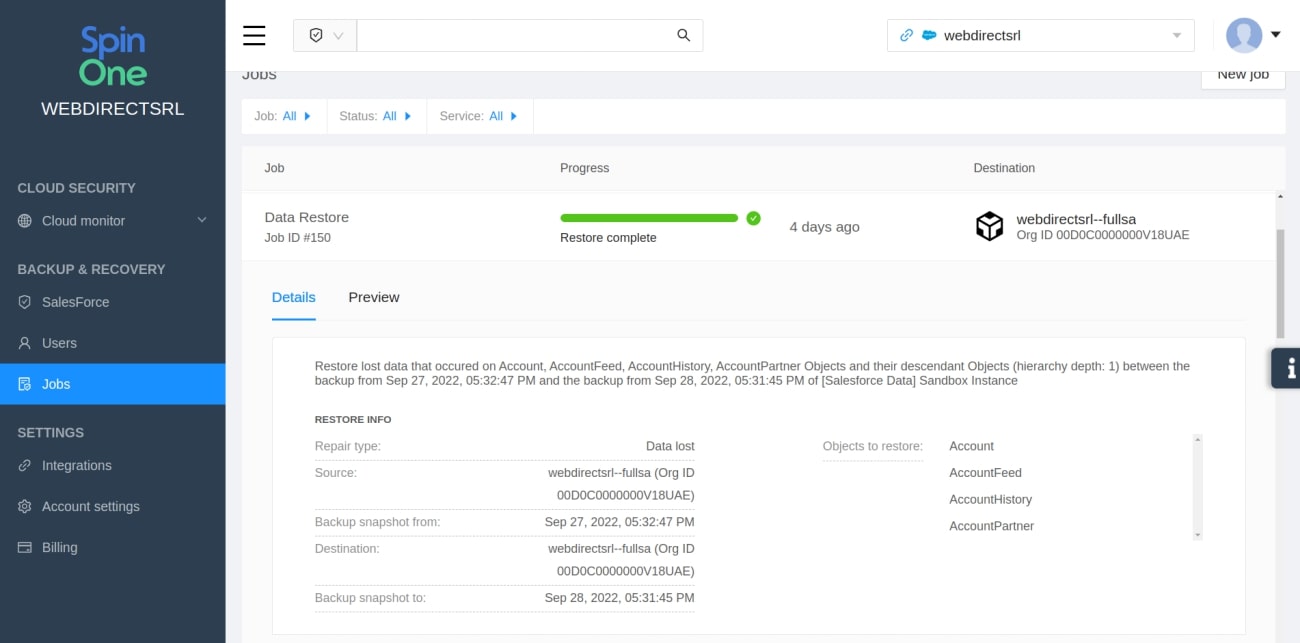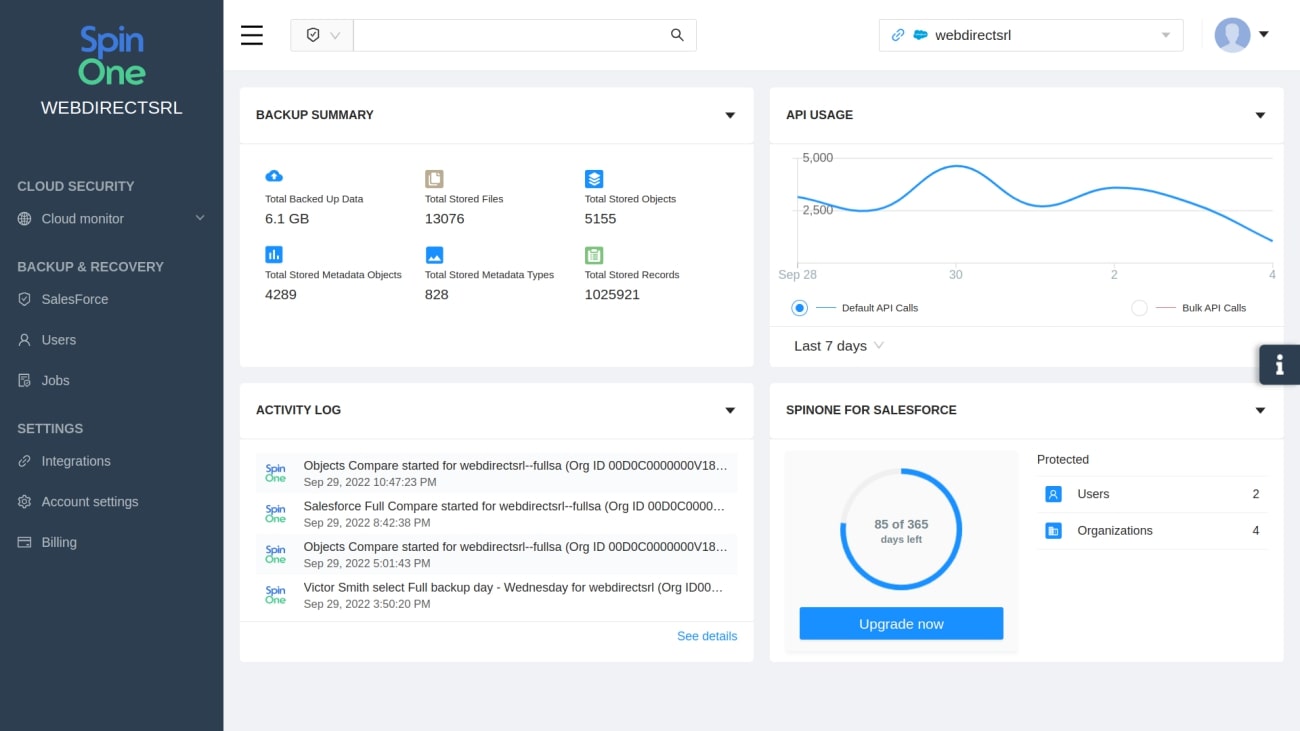Salesforce Backup Solutions Comparison for SMBs
Sales teams store megabytes of business-critical data in Salesforce. Losing it might significantly harm your revenue generation process. That’s why companies back up their information. This article provides a comprehensive comparison of Salesforce backup solutions for SMBs.
We will review several most popular third-party Salesforce backups. We highly recommend against using native Salesforce tools for several reasons we’ll explain in one of the sections below.
Why businesses need to back up Salesforce
There are several reasons why businesses need to back up their data:
1. Salesforce data is critical for revenue generation.
Data that you store in Salesforce is necessary for your sales team to communicate efficiently with existing and potential customers. Losing it can significantly impede their operations and, as a result, your business income.
2. Businesses can lose data in Salesforce due to human error or malicious intention.
Salesforce is a collaboration tool. It means many people can access the data stored there and edit or delete it. Regardless of the reason for data loss, your business needs a backup to restore it.
3. Salesforce doesn’t back up your data. You need special tools.
There is a Salesforce Data Recovery option. It costs $10,000, takes up to 8 weeks, doesn’t include metadata, and provides data as a CSV file.
4. Your business risks having a compliance breach.
Specific rules and regulations governing SaaS data in some countries mandate data retention. The data loss might be subject to fines and/or lawsuits.
Read more about Salesforce backup and its value for your business.
What Salesforce data should businesses back up?
In Salesforce, there are three types of data:
- Objects like Account, Contact, User, etc. They contain data about your potential and existing clients and activities your business has done with them.
- Files are any file attachments to objects that provide additional information (like videos, pdfs, documents, presentations, etc.).
- Metadata demonstrates the relations between objects. Metadata represents the structure of your sales pipeline.
We highly recommend that companies back up all three types of data. Some Admins think that metadata doesn’t need backup. However, if your company has a development team that introduces changes to a sales pipeline, we suggest backing up metadata as well.
What functionality to look for in Salesforce backup
When choosing a Salesforce backup solution we suggest looking for the following functionality:
1. Automated backup option
If your business only manually backs up data, there is a high chance that a person in charge of this task will forget about it. As a result, some data will remain unprotected.
2. Backup frequency
Backup frequency depends on the number of changes introduced to your Salesforce on a regular basis. The basic backup frequency in third-party tools is once a day, but some tools like SpinOne also provide a three-time-per-day automated backup. In this article, we explain how your recovery objective influences your backup frequency strategy.
3. Recovery format
Most native tools provide a CSV file that you then need to manually upload to Salesforce. Meanwhile, third-party tools recover data as it is directly into Salesforce with minimal engagement of your team.

4. Types of data backed up
As we mentioned above, for most companies, backing up all types of Salesforce data is critical (objects, metadata, and files). Note that unlike SpinOne most legacy backup solutions do not back up all types of files.
5. Sandbox backup
Most native tools do not back up Salesforce Sandbox. Meanwhile, this functionality is critical for businesses that have Salesforce development teams and actively work on its customization.
6. Compare tool
Compare tool is the functionality of most third-party tools. It enables you to compare two backups of your Salesforce data or metadata or a current version of Salesforce organization with any given backup. Learn more about the Salesforce Compare feature.

7. Granular recovery
This is the ability to recover only a portion of data from a certain point in time in the past. Learn more about Salesforce data recovery.
8. Backup and recovery speed
Third-party Salesforce backup solutions apply APIs to back up and restore data. Similar to any SaaS tool, the number of APIs per minute is limited. Most legacy backups apply only one type of API. Meanwhile, SpinOne uses both types and has an intelligent API utilization system. This feature enables us to back up, compare and recover data faster while not overloading the APIs.
9. Single pane of glass
Keep in mind that most native tools only back up one type of data. Meanwhile, third-party tools provide a single pane of glass for all the functionality. Furthermore, some solutions like SpinOne also provide backup functionality for other SaaS environments (like Google Workspace or Microsoft Office 365). They provide a single platform for all these backups.
Learn more about Salesforce backup functionality here. Need to backup other SaaS apps? Check out Microsoft 365 backup.
Native vs. Third-party Salesforce Backup Solutions
Salesforce has several native backup solutions. Most of them do not fit the needs of modern businesses. If you are interested in a comparison of third-party backup solutions, skip this section and scroll down to the next one.
Here are some popular native Salesforce backup solutions:
- Salesforce Backup&Restore
- Data Export Service
- Data Loader and Report Export
- Change Sets
Here are some popular native Salesforce recovery solutions:
- Salesforce Recycle Bin: Salesforce has a recycle bin feature that retains deleted records for a certain period. However, it’s important to note that the recycle bin has limited retention time, usually 15 days for most objects, after which the data is permanently deleted.
- Paid Restoration: Salesforce offers a paid data restoration service where you can request the recovery of deleted data beyond the Salesforce recycle bin retention period. This service incurs additional costs and has limitations in terms of the time it takes to restore the data.
- Data Loader: Salesforce Data Loader is a tool that allows you to extract, insert, update, and delete data in Salesforce. While it can be used for data recovery purposes, it requires manual effort and is not designed specifically for backup and recovery.
We created a short table to demonstrate the native vs. third-party Salesforce backup solutions comparison. Please note that we created a separate column for Salesforce native tool Backup&Restore because it has a more advanced functionality compared to other native tools. However, it also lacks some important features that third-party solutions have.
| Features | Most Native Tools | Salesforce Backup&Restore | Third-party tools |
| Types of data | One type of data per tool | Objects & files | All types of data |
| Automated backup | Some tools | Yes | Yes |
| Backup frequency | Once a month or week | Once a day | 1-3 times a day |
| Direct recovery to Salesforce | No | Yes | Yes |
| Recovered data format | CSV file | As it is | As it is |
| Compare functionality | No | No | Yes |
| Granular recovery | No | Yes | Yes |
| Reporting | No | Yes | Yes |
Now, let’s take a closer look at the third-party Salesforce backups.
Third-party Salesforce Backup Solutions Comparison
This section compares four third-party Salesforce backup solutions: SpinOne, CloudAlly, AvePoint, and OwnBackup. First, we provide a comparison table of the key features and then a short overview of each tool.
| Features | OwnBackup | AvePoint | CloudAlly | SpinOne |
| On-demand backup | V | V | V | V |
| Scheduled backup 1x | V | V | V | V |
| Scheduled backup 3x | – | – | – | V |
| Utilization of 2 types of APIs | – | – | – | V |
| CSV Export | V | V | V | V |
| Compare tools | V | V | V | V |
| Recovery | V | V | V | V |
| On-page restore | – | – | – | V |
| Unlimited storage | V | V | V | V |
| Sandbox seeding | V | – | V | V |
| Data anonymization | V | – | V | V |
| Multi-org support | V | V | V | V |
| Metadata backup | V | V | V | V |
| Org comparing | V | V | V | V |
| API calls monitoring | V | V | V | V |
| Change alerts | V | V | – | V |
| Backup for other services | MS Dynamics | Office 365, MS Dynamics | GW, O365, Box, Dropbox | GW, O365 |
SpinBackup Salesforce Backup
SpinOne is a platform with data protection functionality for three SaaS environments: Google Workspace, Microsoft Office 365, and Salesforce. It offers a backup solution for Salesforce with a comparison feature and granular recovery.

Our three main competitive advantages are backup and recovery speed due to smart API utilization, backup of all files, and correct classification of all the objects. Other SpinOne Salesforce backup solution functions are as follows:
- Automated and on-demand backups
- Backup frequency up to 3 times per day
- Types of data: metadata, files, and objects
- Data encryption in transit, in use, and at rest.
- The fastest performance due to the utilization of 2 types of APIs
- Point-in-time recovery of chosen entries
- Backup, restoration, and seeding of Sandbox
- Compare Orgs and Sandboxes
- Multi-org support
- Unlimited storage on AWS, GCP, Azure, or BYOS
- Integration with Slack and Splunk
- Single pane of glass for Salesforce, MSO 365, and GW
OwnBackup
OwnBackup is a solid Salesforce backup option. It has many basic features necessary for any business such as automated backup of all types of data and Sandbox. However, sandbox seeding, for example, is subject to separate pricing. Also, the tool doesn’t have on-page restore.
AvePoint
AvePoint is another legacy Salesforce backup. It uses Azure as its storage and has a monitoring dashboard. AvePoint lacks several features that are critical to many businesses. These are on-page restore, data anonymization, and sandbox seeding.
CloudAlly
CloudAlly is a good solution with basic functionality. Similar to most third-party backup solutions, CloudAll doesn’t use 2 types of APIs and thus cannot provide the performance speed that meets the needs of modern businesses. It also lacks change alerts.
Was this helpful?
How Can You Maximize SaaS Security Benefits?
Let's get started with a live demo
Latest blog posts
Why a Reliable Backup Plan is Your Best Defense Against Cybersecuri...
…and the Most Boring Way to Protect Your Organization I’ve written about the importance of...
Why Google Drive Backups Are Important
Google Drive offers customers a unique blend of robust security features to keep their data...
Evaluating the Best Backup Services: What to Look For and Popular O...
If you’re here right now you’ve probably realized how important it is to backup your...

